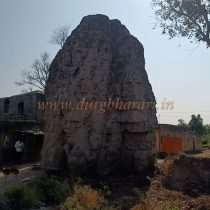TAKLI BHOKARDAN
TYPE : FORTRESS
DISTRICT : JALNA
In the pre-independence era, Marathwada was under the rule of the Nizam, so the administrative system there was completely different. The center for collecting revenue in this area was in the form of a fortress. Apart from this, some of the noble chieftains as well as the landlords also built forts and fortresses around the mansion for their own protection. Due to this, while wandering around Marathwada, we get to see numerous fortresses in Marathwada. One such ruined fortress can be found on a small hill on the banks of the Kelna River in the village of Takli near Bhokardan. Although this fortress has largely fallen down in the course of time, some ramparts and two bastions still remain. These ruins are also companions of few time as local people use the stone and soil from here to build their houses.
...
There are many villages called Takli in Maharashtra and there are two villages in Jalna district one in Bhokardan taluka and one in Jafarabad taluka. Importantly, both these villages are located on the banks of the Kelna River on the Bhokardan-Jafarabad route. The village we are visiting now is known as Takli Bhokardan as it is in Bhokardan taluka. Takli Bhokardan village is 15 km from Bhokardan taluka and 25 km from Jafarabad. This village is about 5 km inland from Sipora Bazar junction on Bhokardan-Jafarabad highway. Since both Jafarabad and Bhokardan were important cities in the medieval period, it was natural that trade would flourish in both these cities. Due to scarcity of water in Marathwada, the trade and military travel between these two cities used to take place along the Kelna River. Therefore, this fortress must have been built to protect the banks of the Kelna River and to keep an eye on this route. After crossing the river and entering Takli village, a small road leads to the old Takli village. On this way, the ruins of the fortress can be seen on a hill on the left side of the river. Although no bastion is visible on this hill today, two white bastions of soil and ramparts can be seen on the lower slope. The stones from this construction are used to build the houses around the fortress. At some distance from here there are four memorials built of stone. Locals say that it belongs to the Gosavi community and belongs to the Giri family, but they cannot tell anything about the fortress. Since this part of Marathwada was under the control of the Nizam and the use of the fortress was stopped during the Nizam period, the history of it is not known. As there are not many remains, 15 minutes is enough to see the fortress and memorial.
© Suresh Nimbalkar















